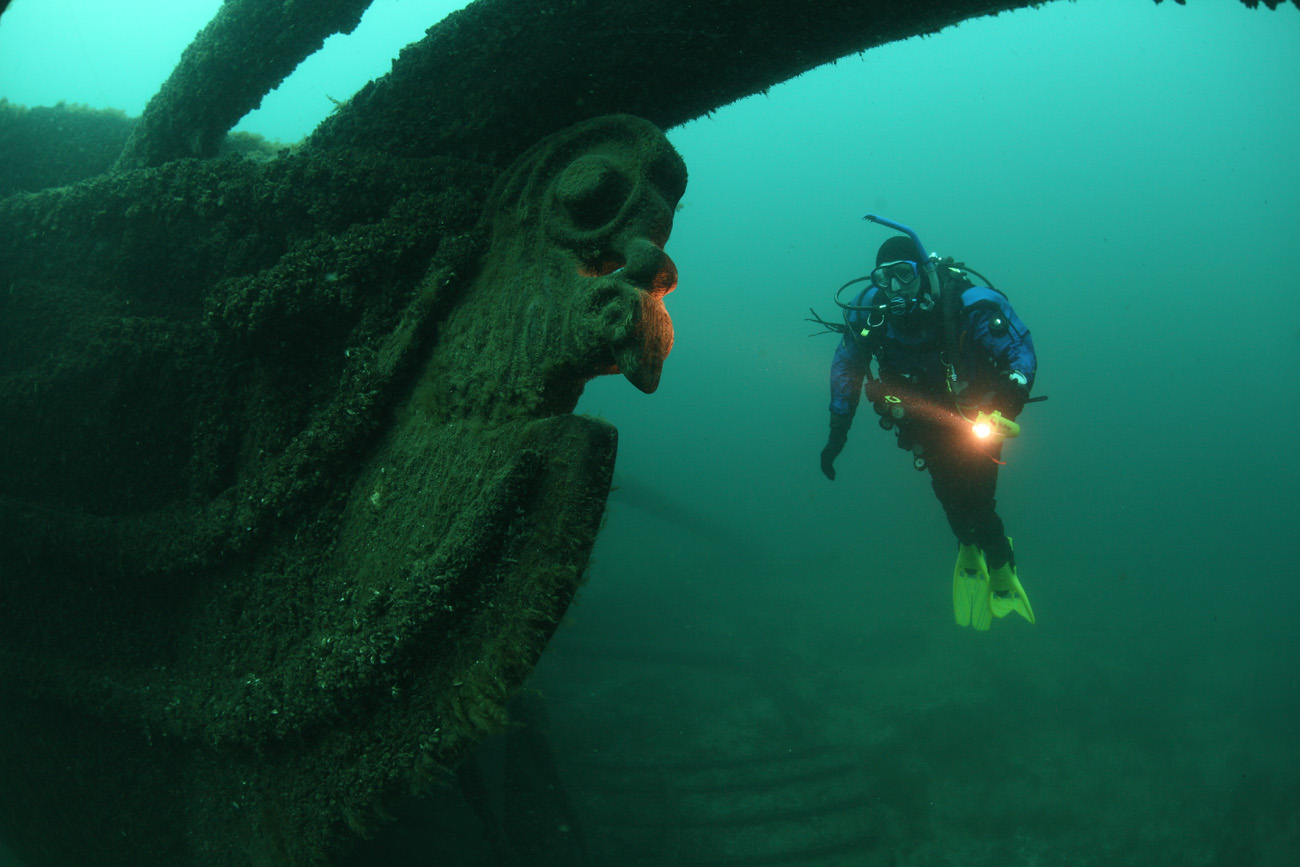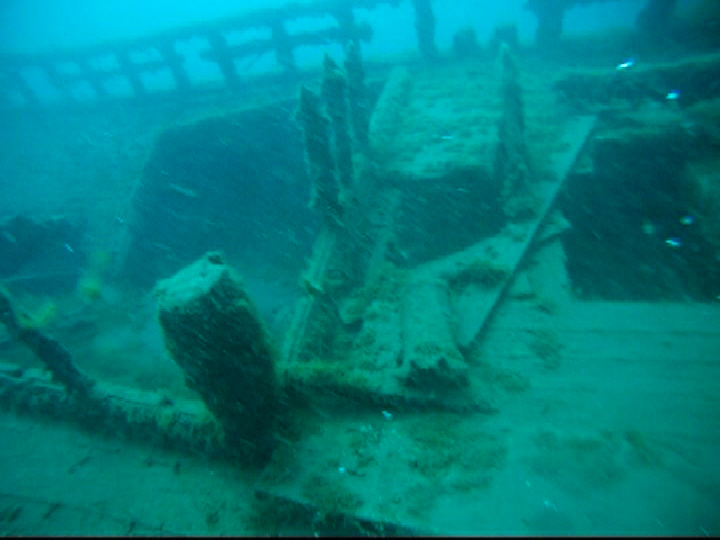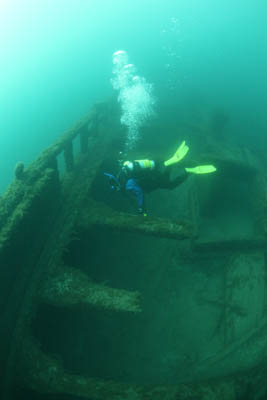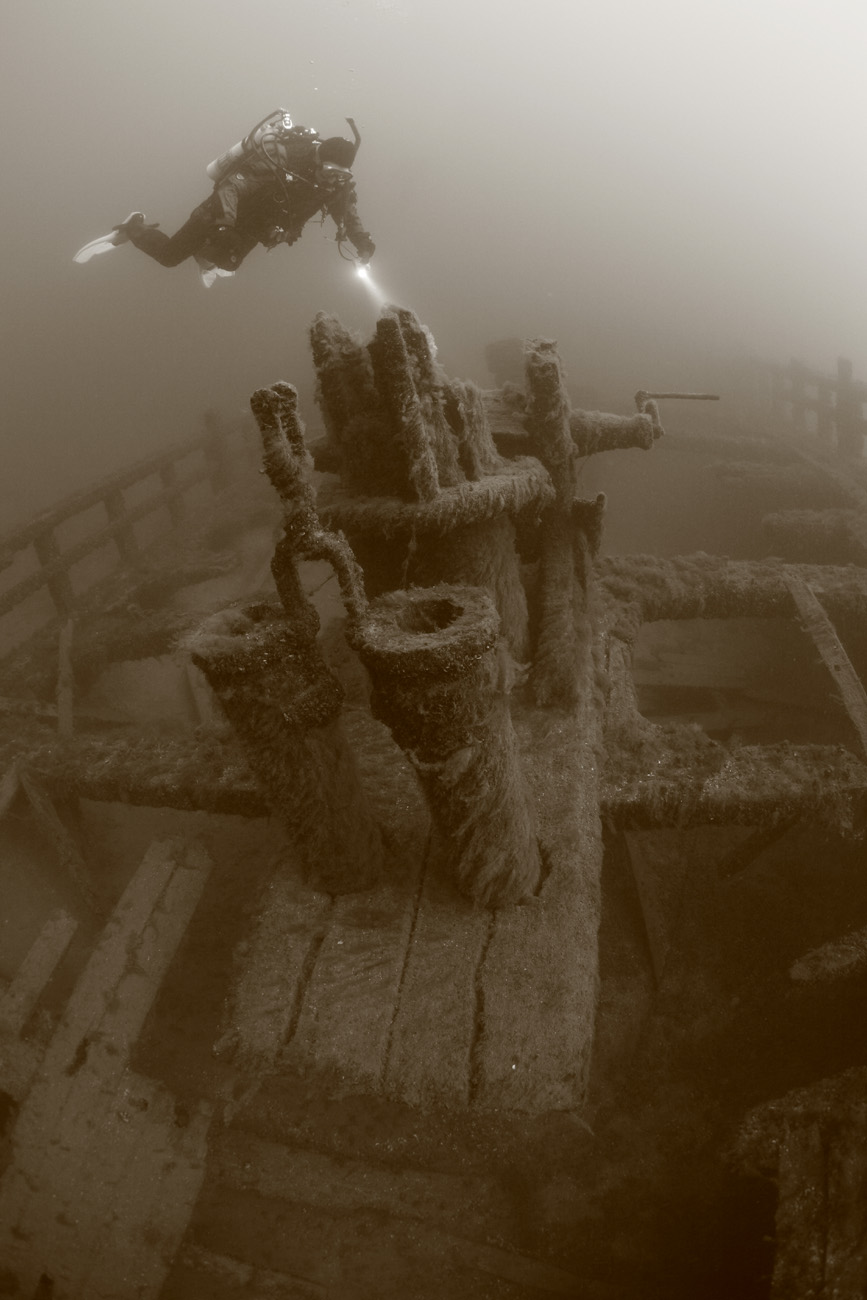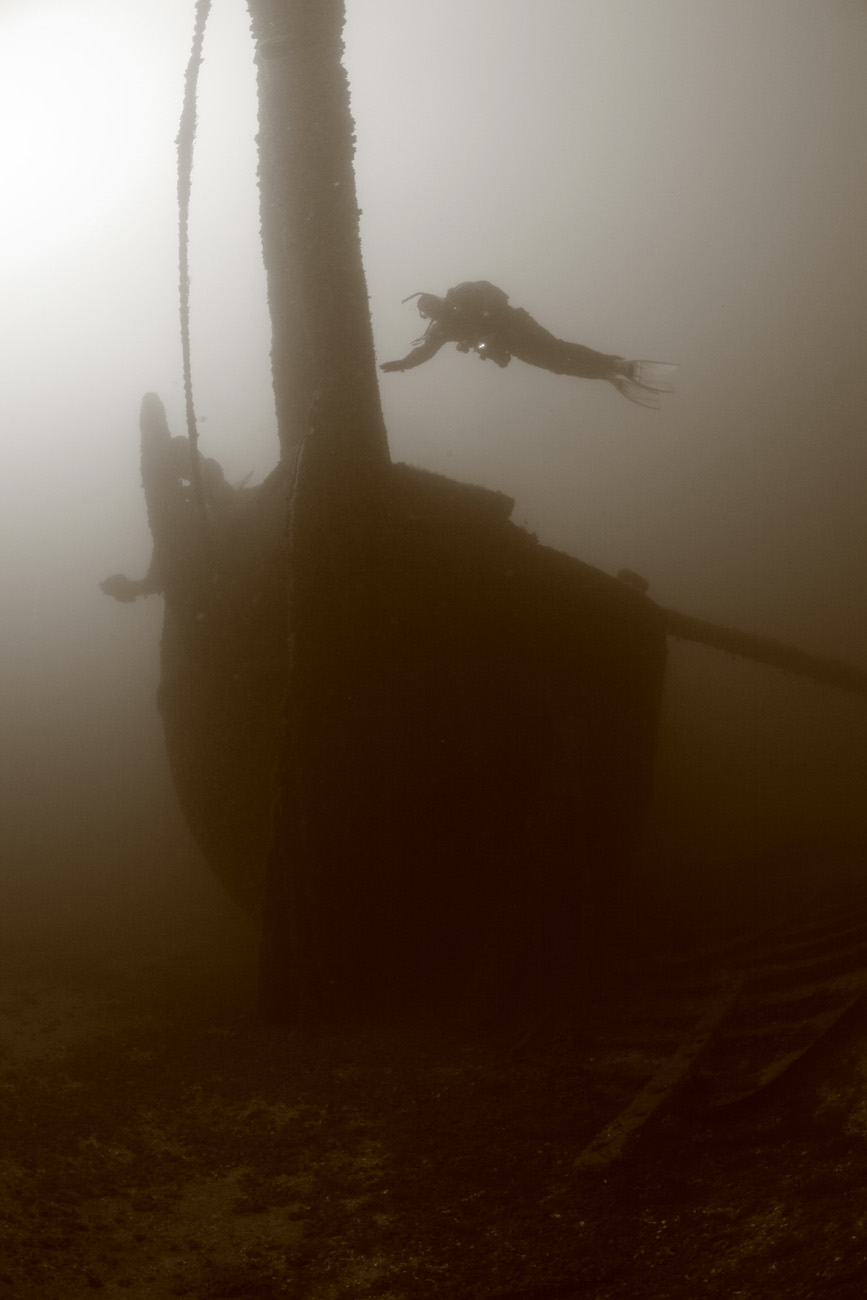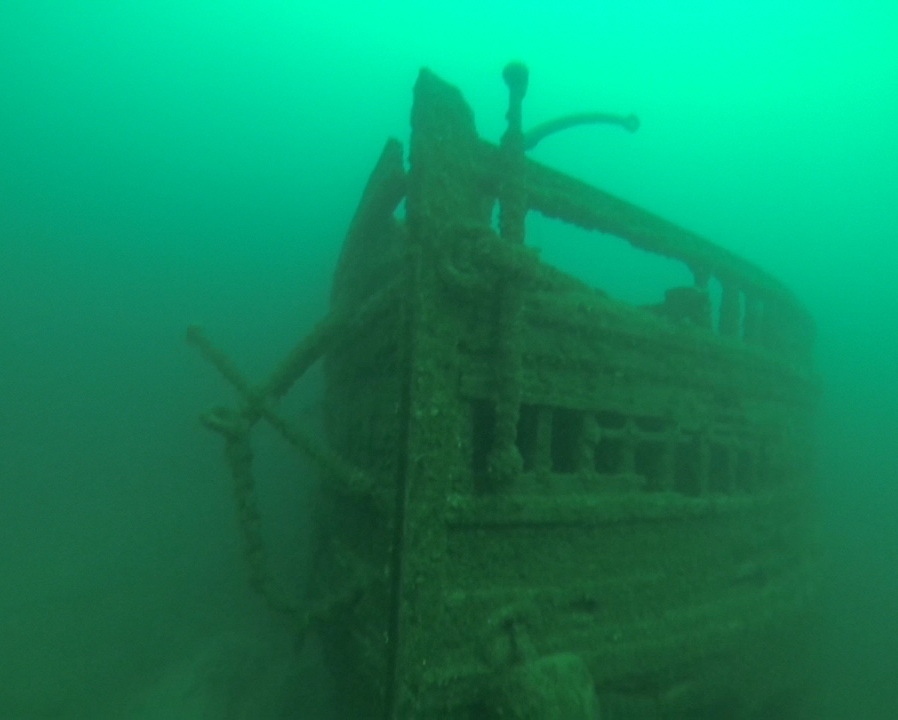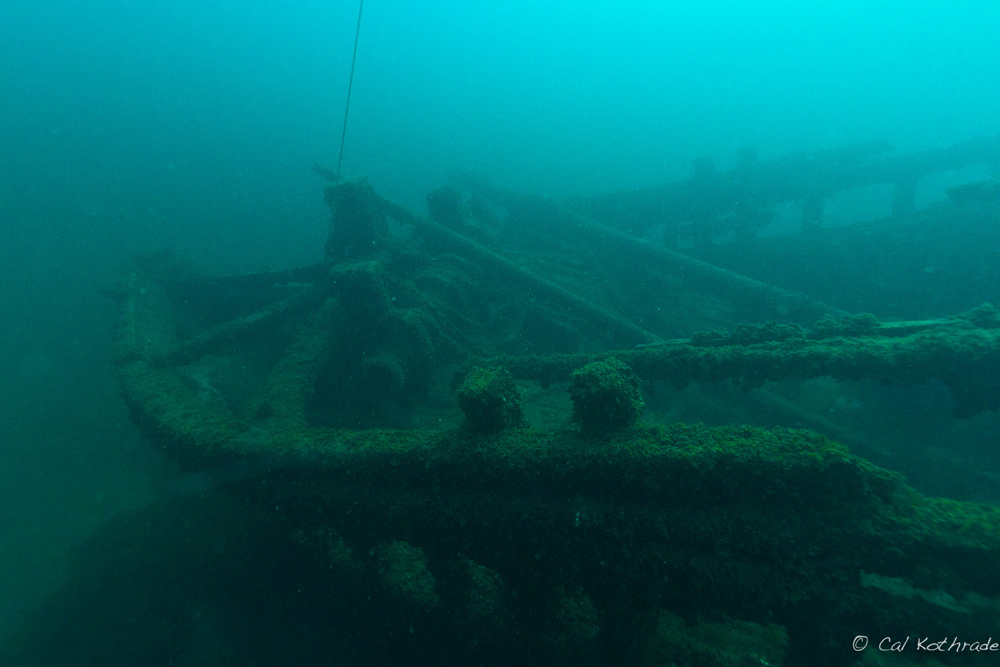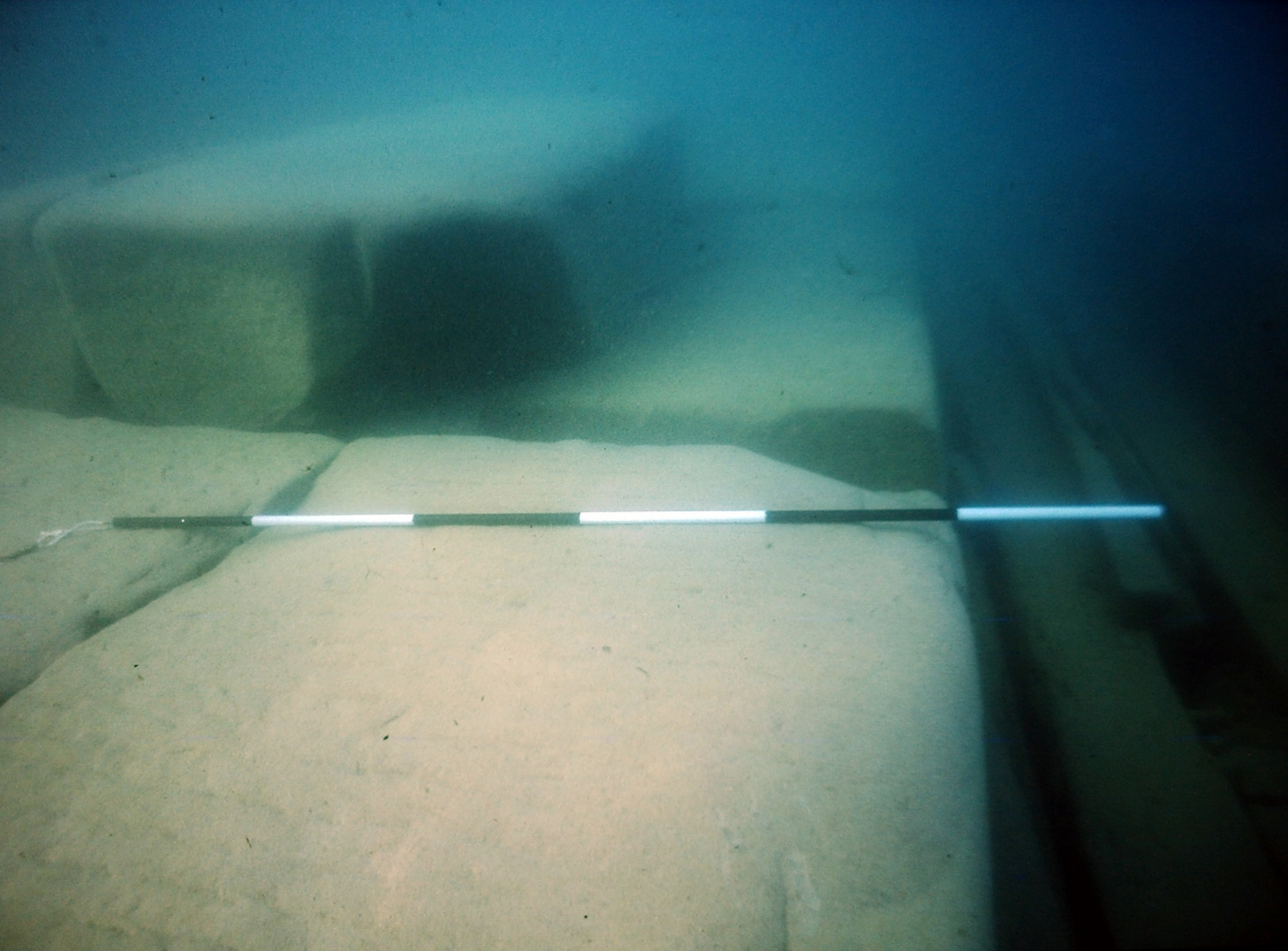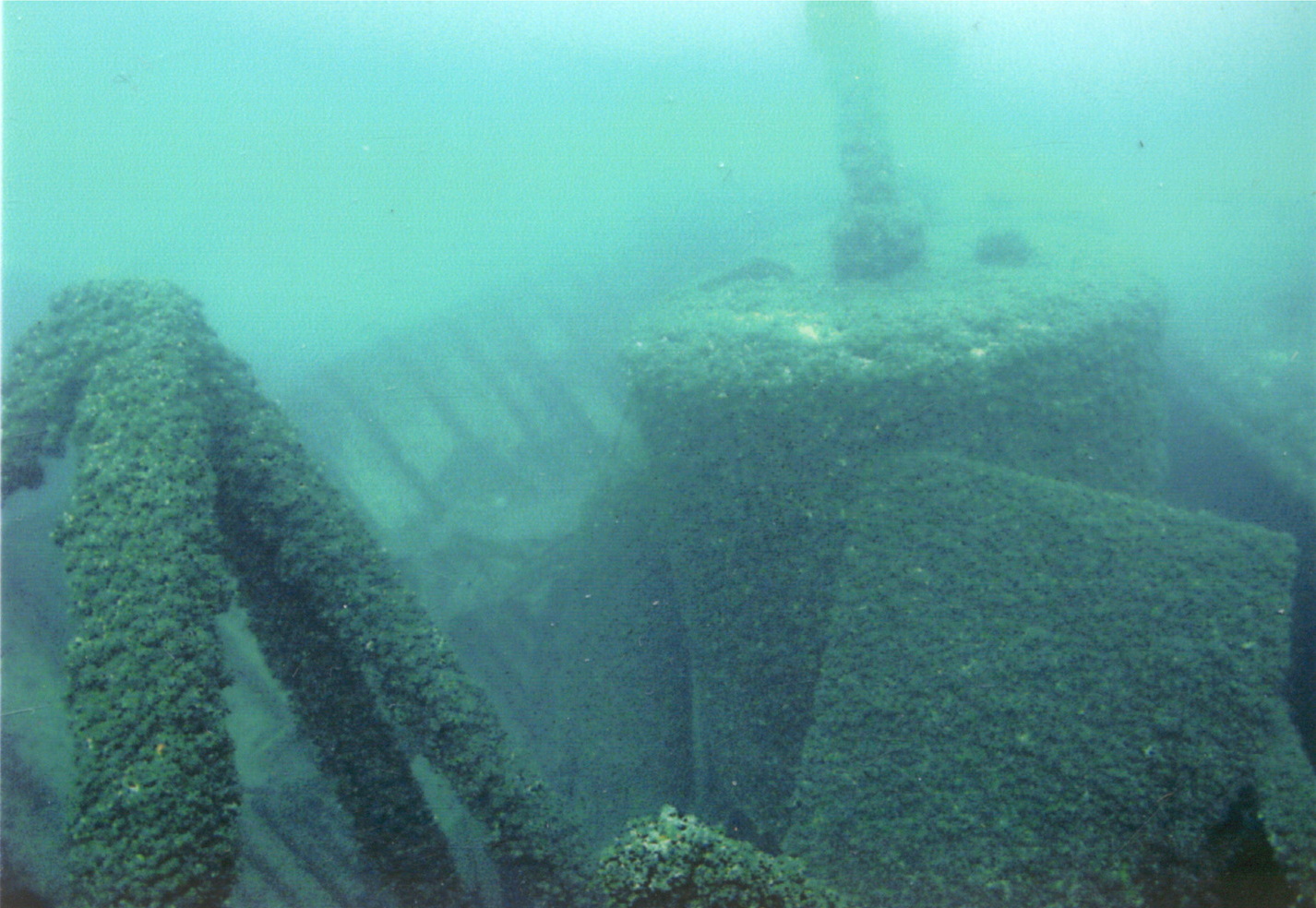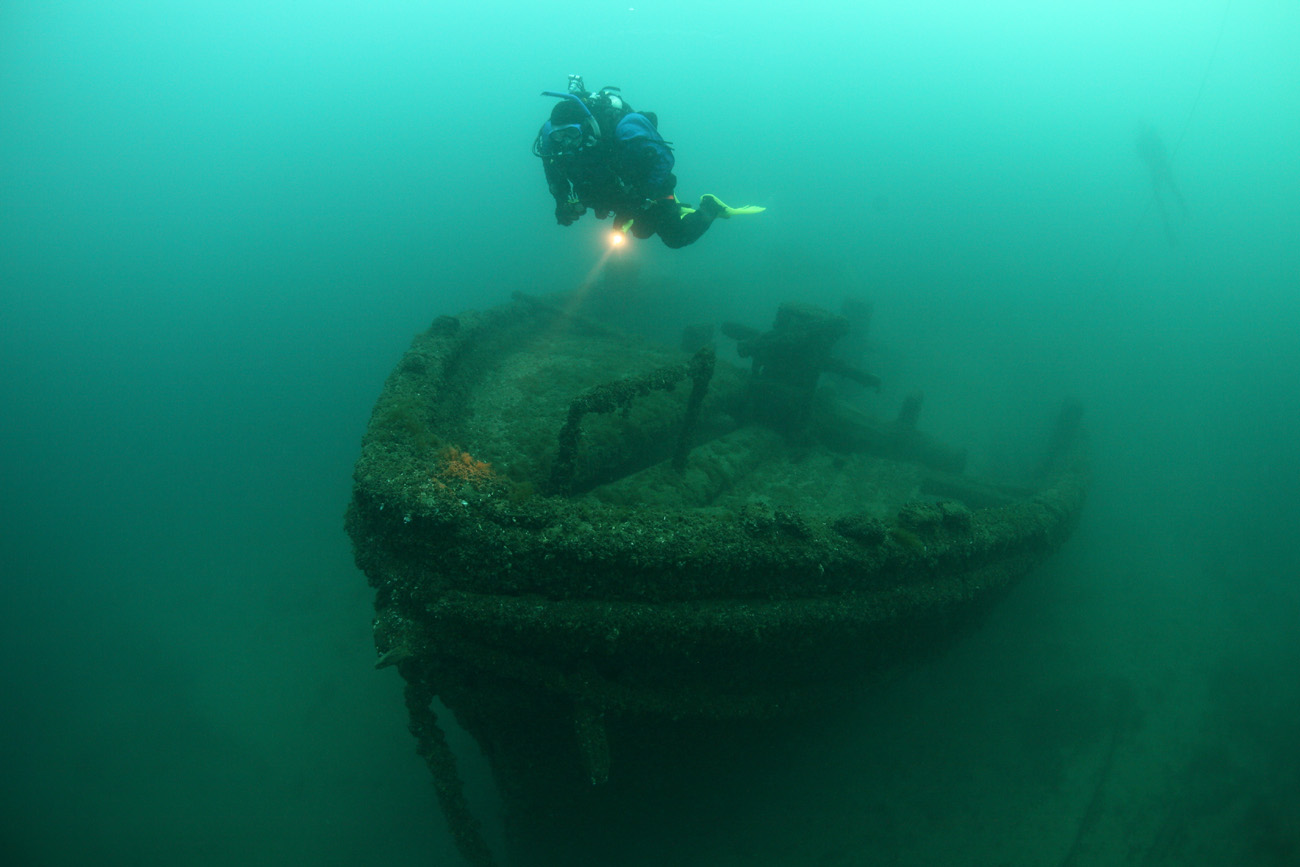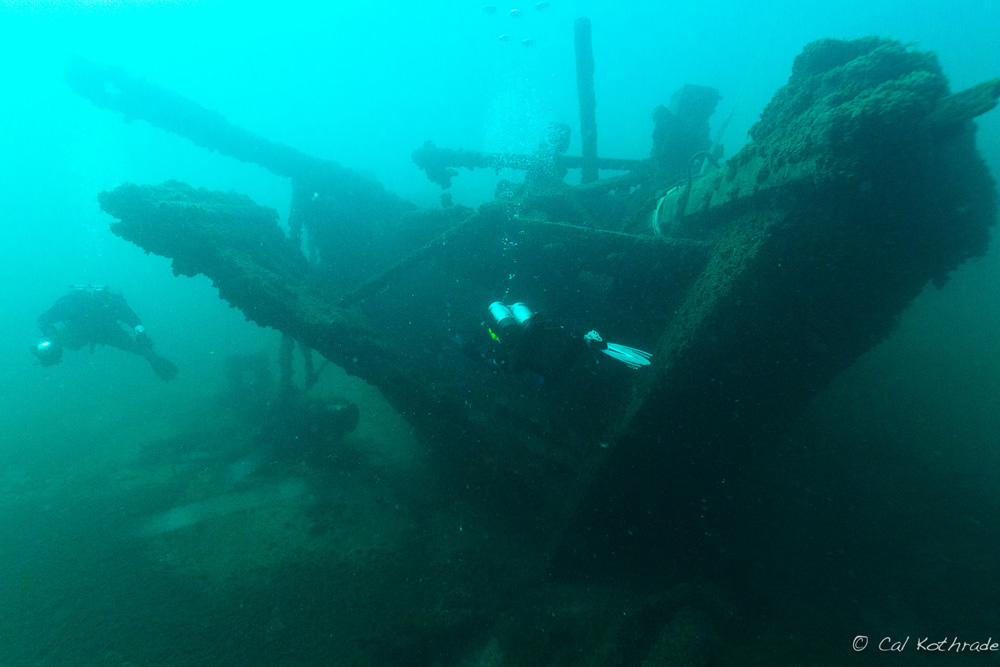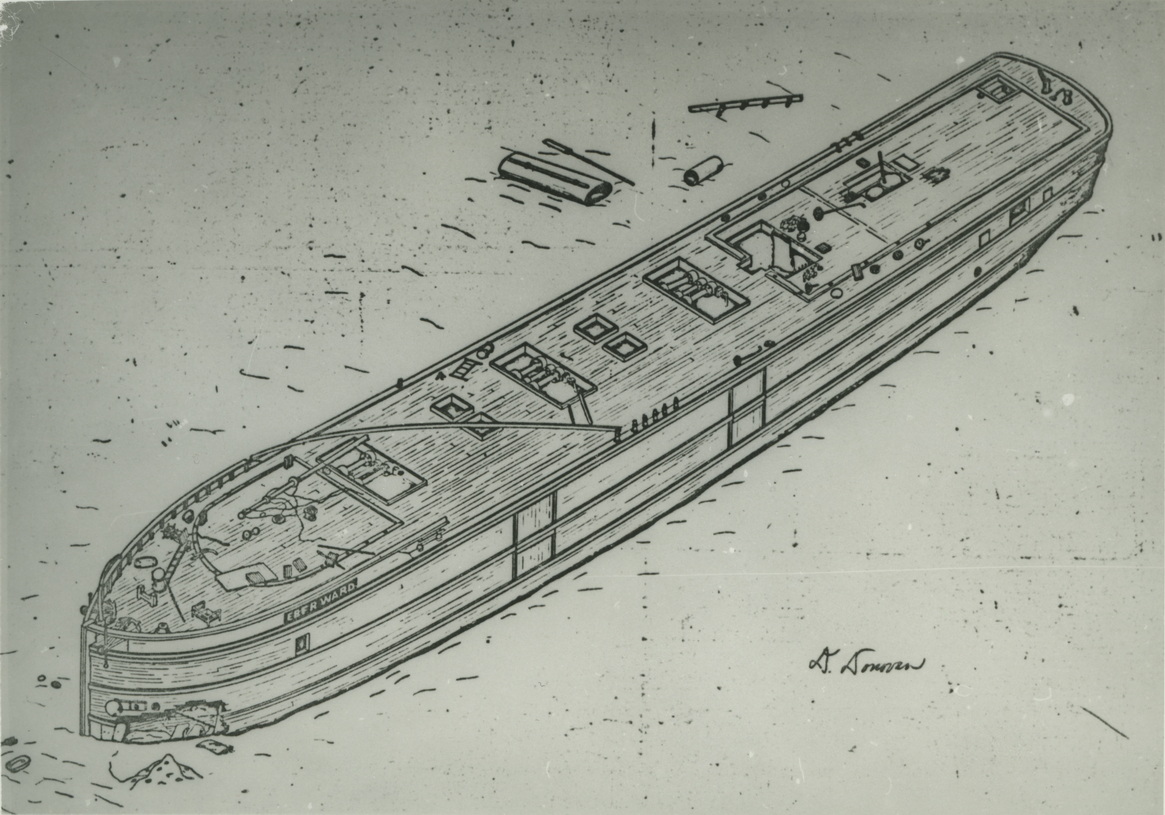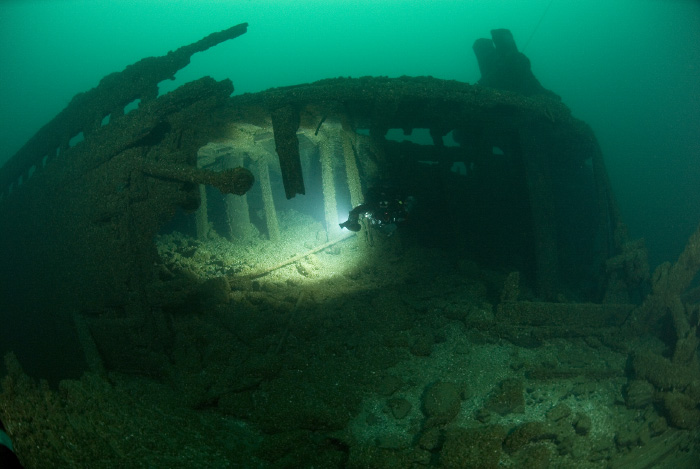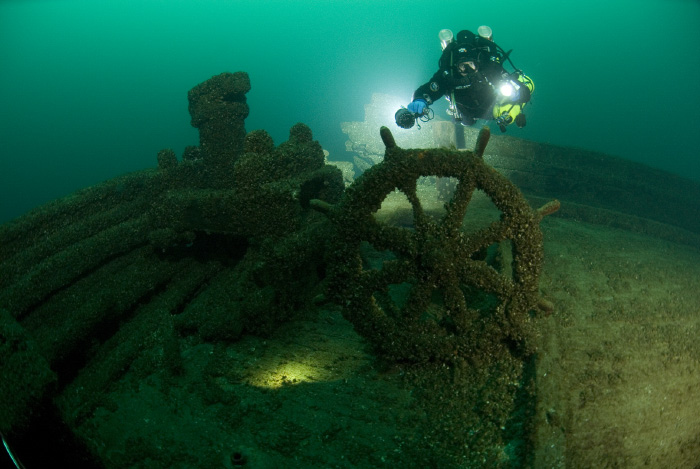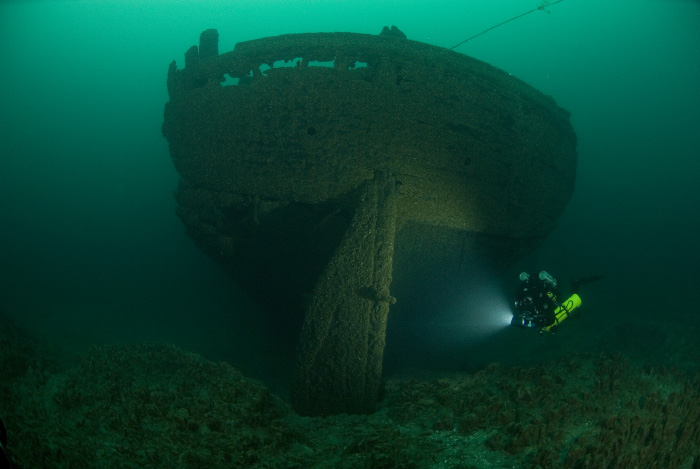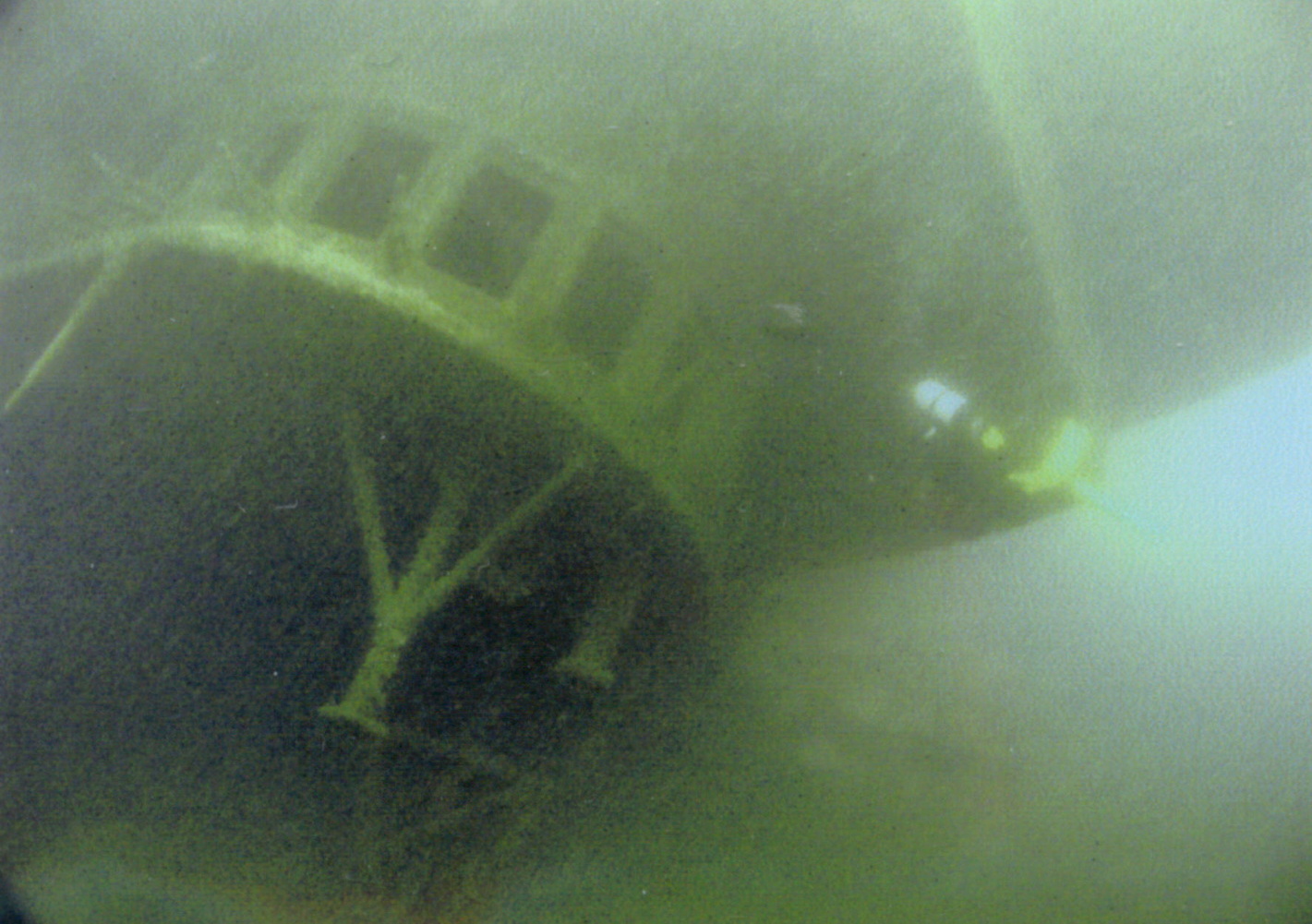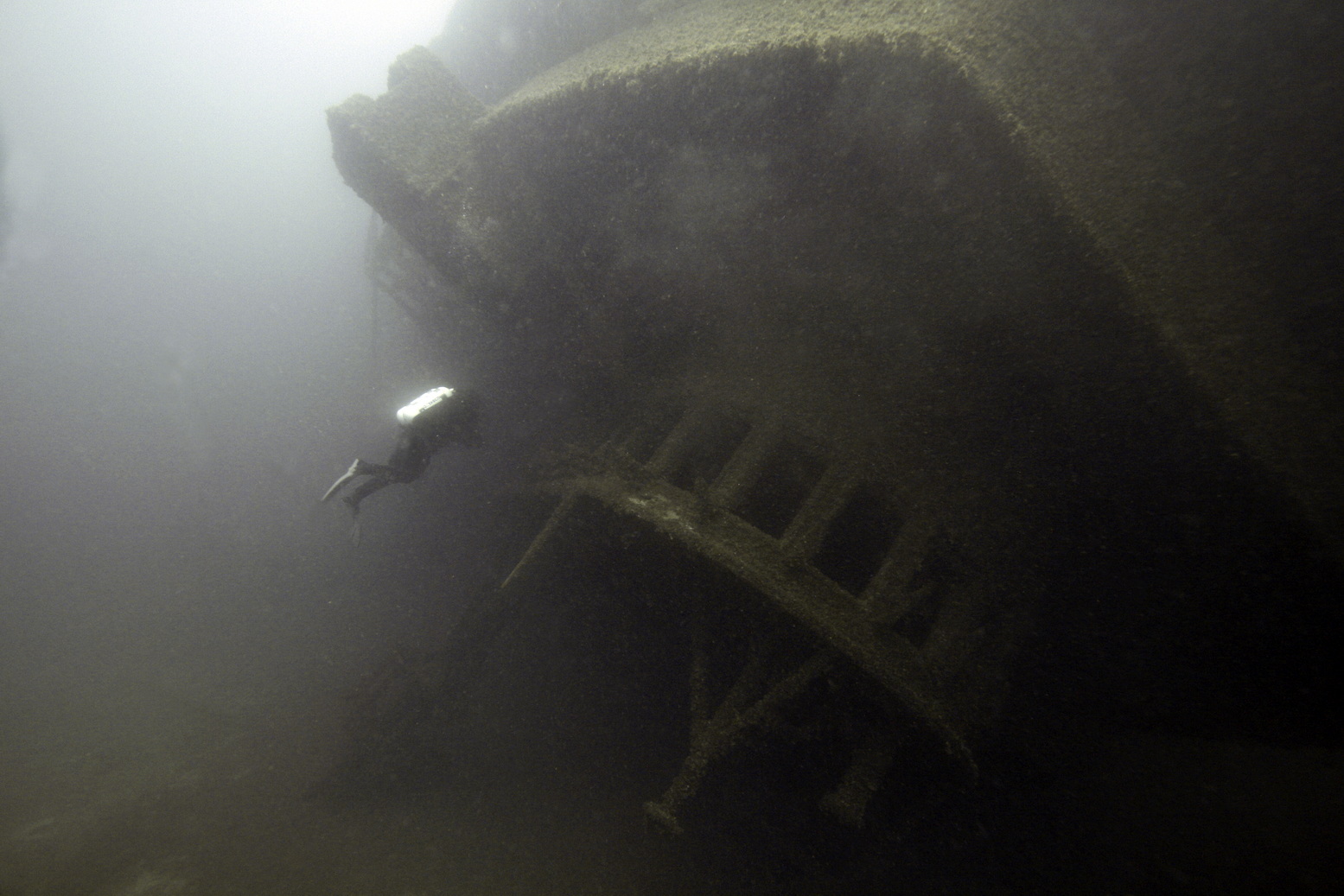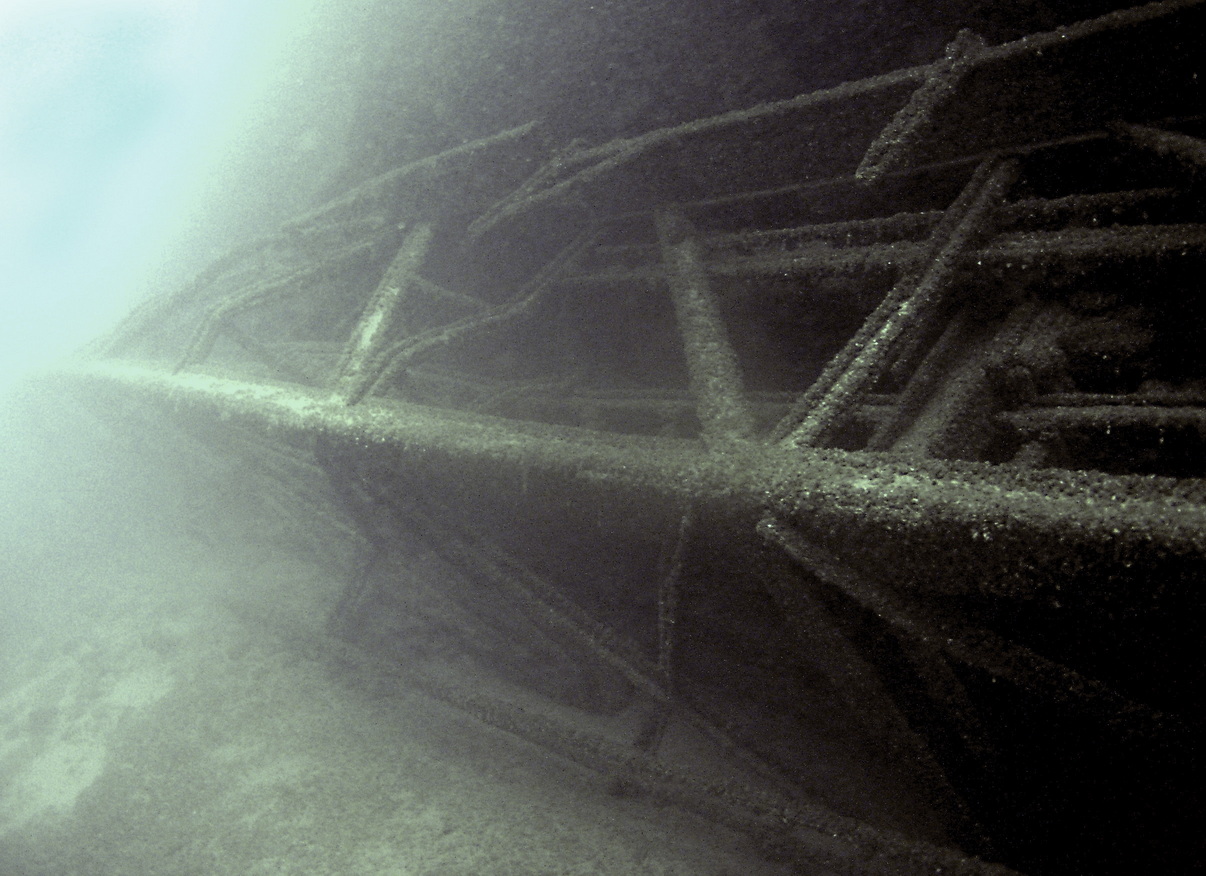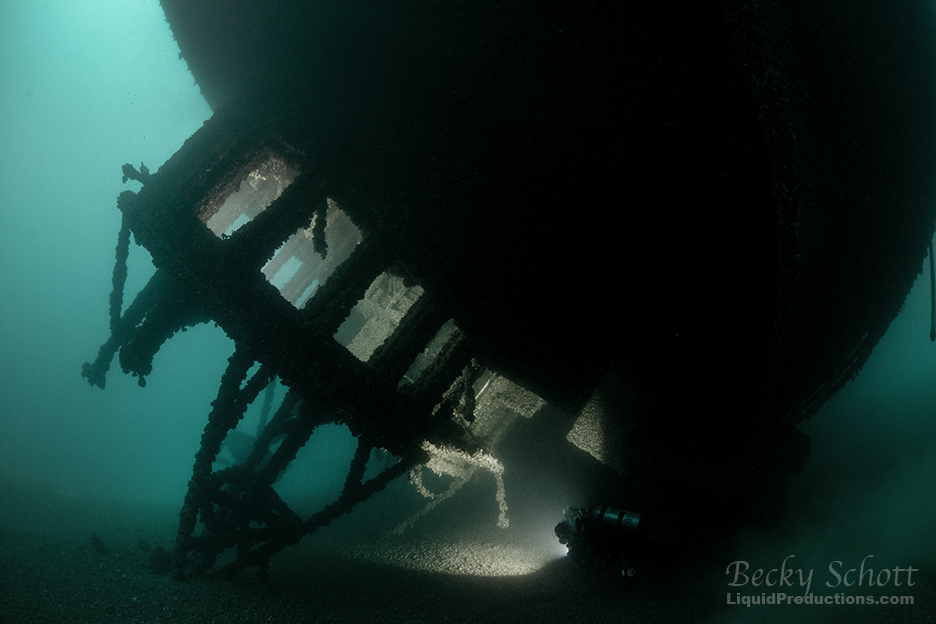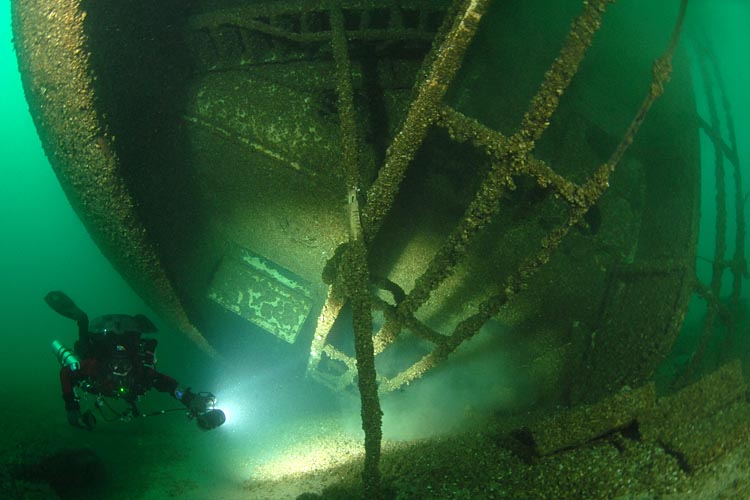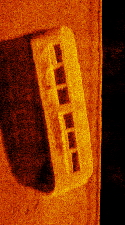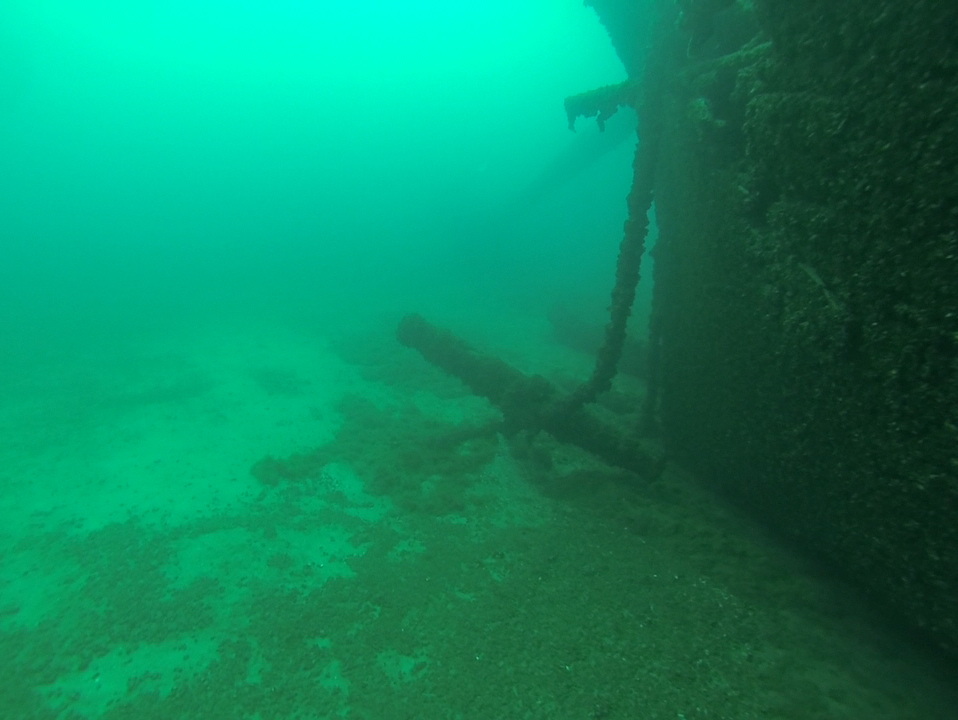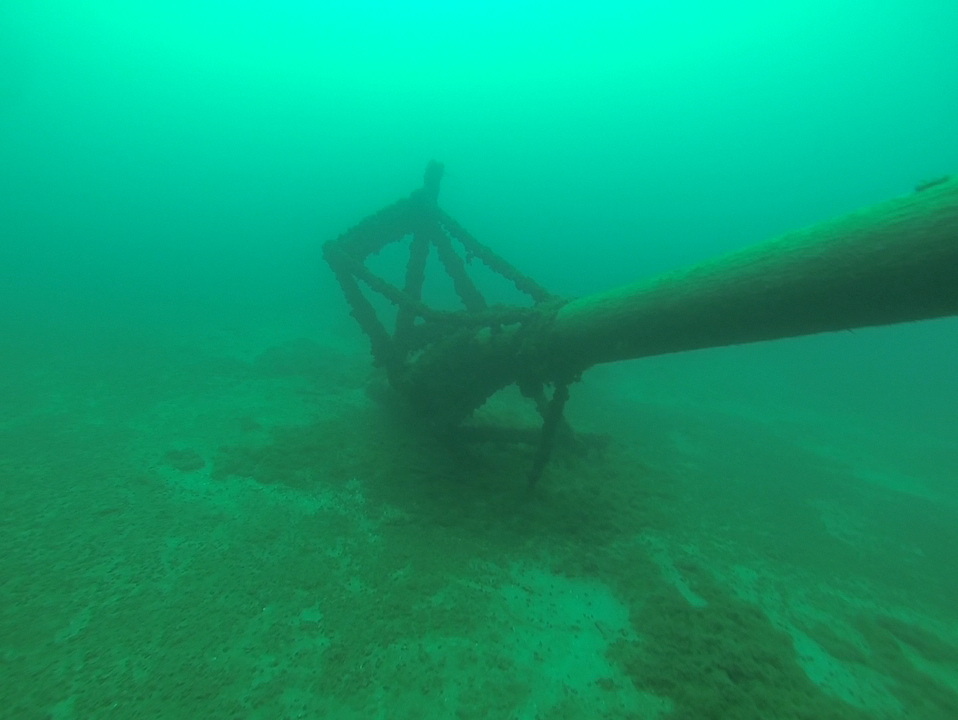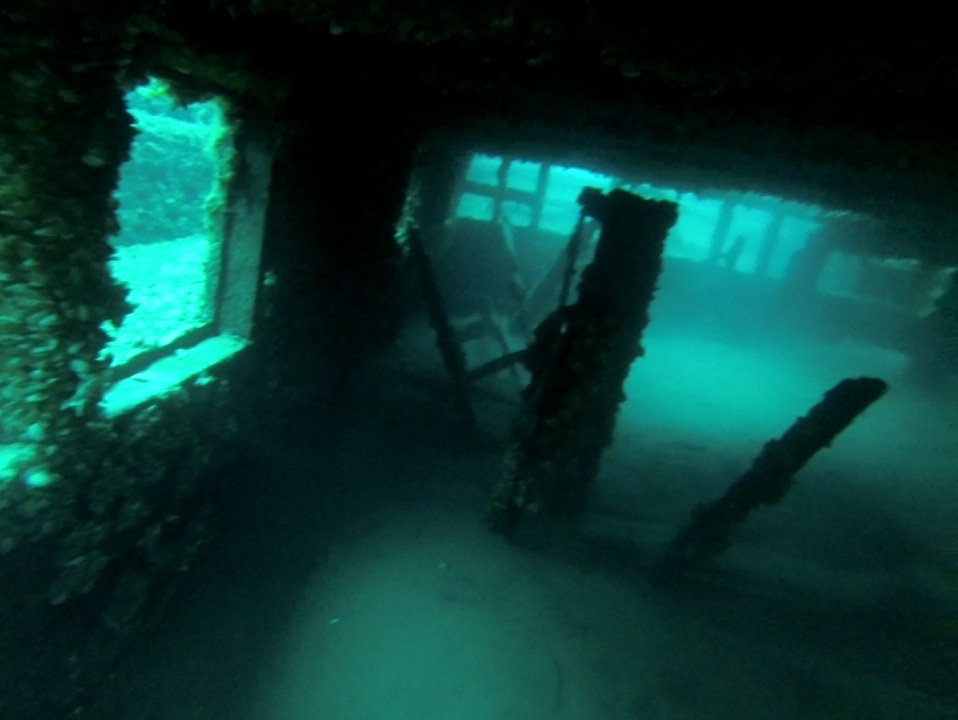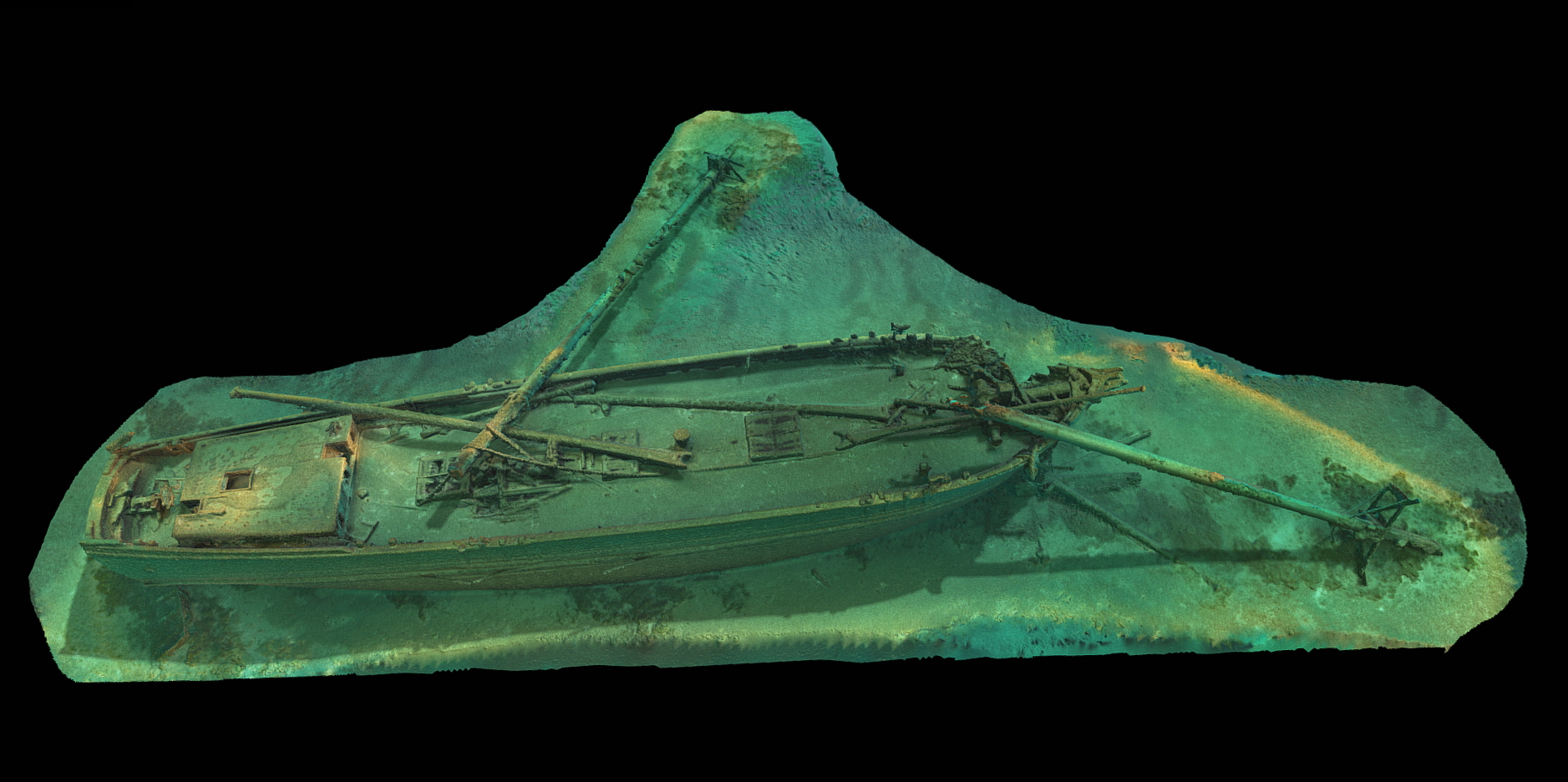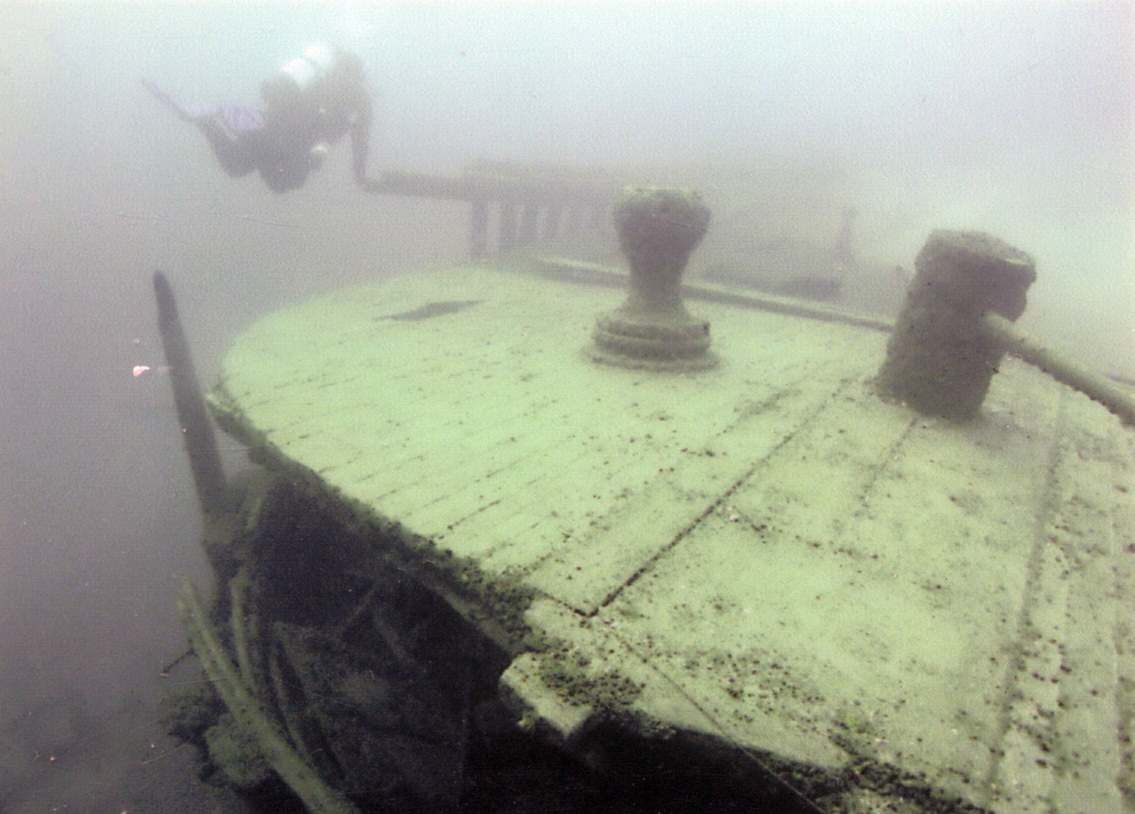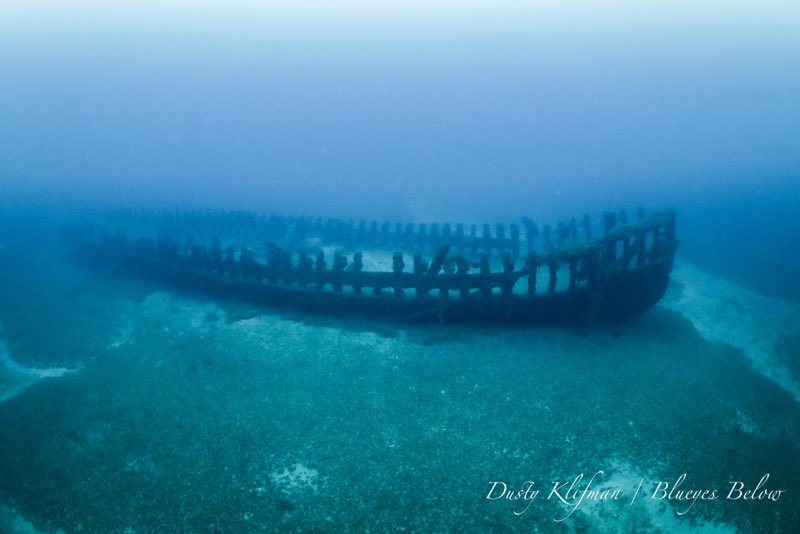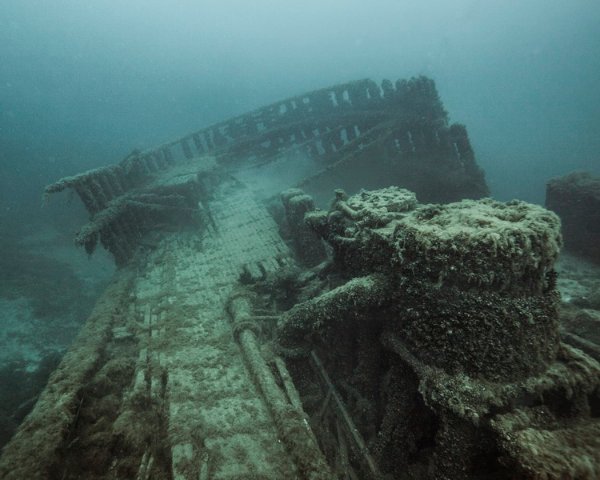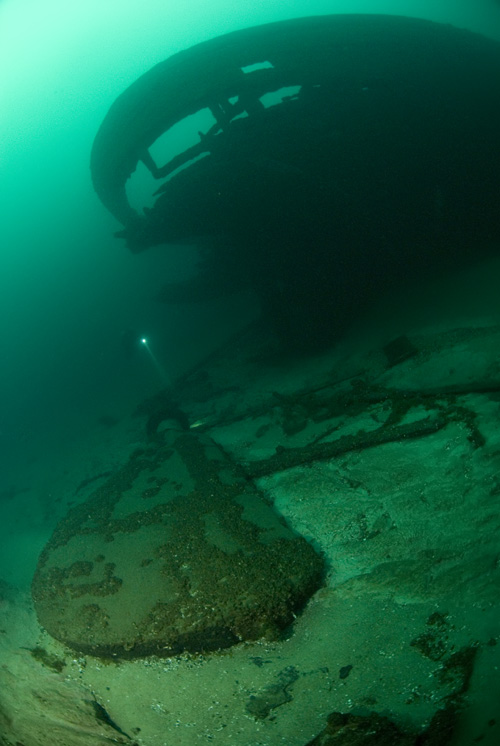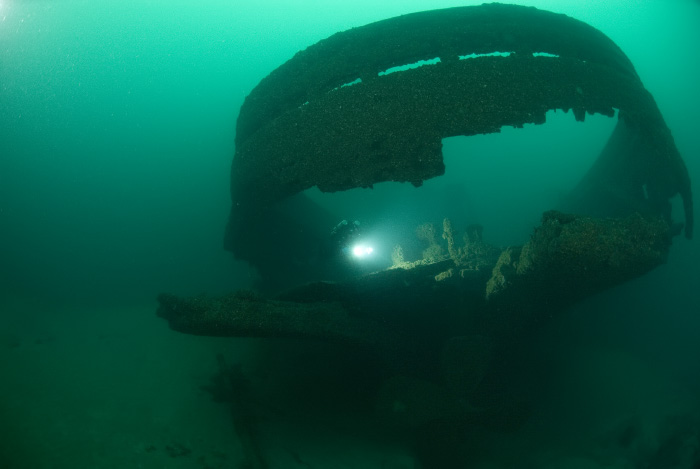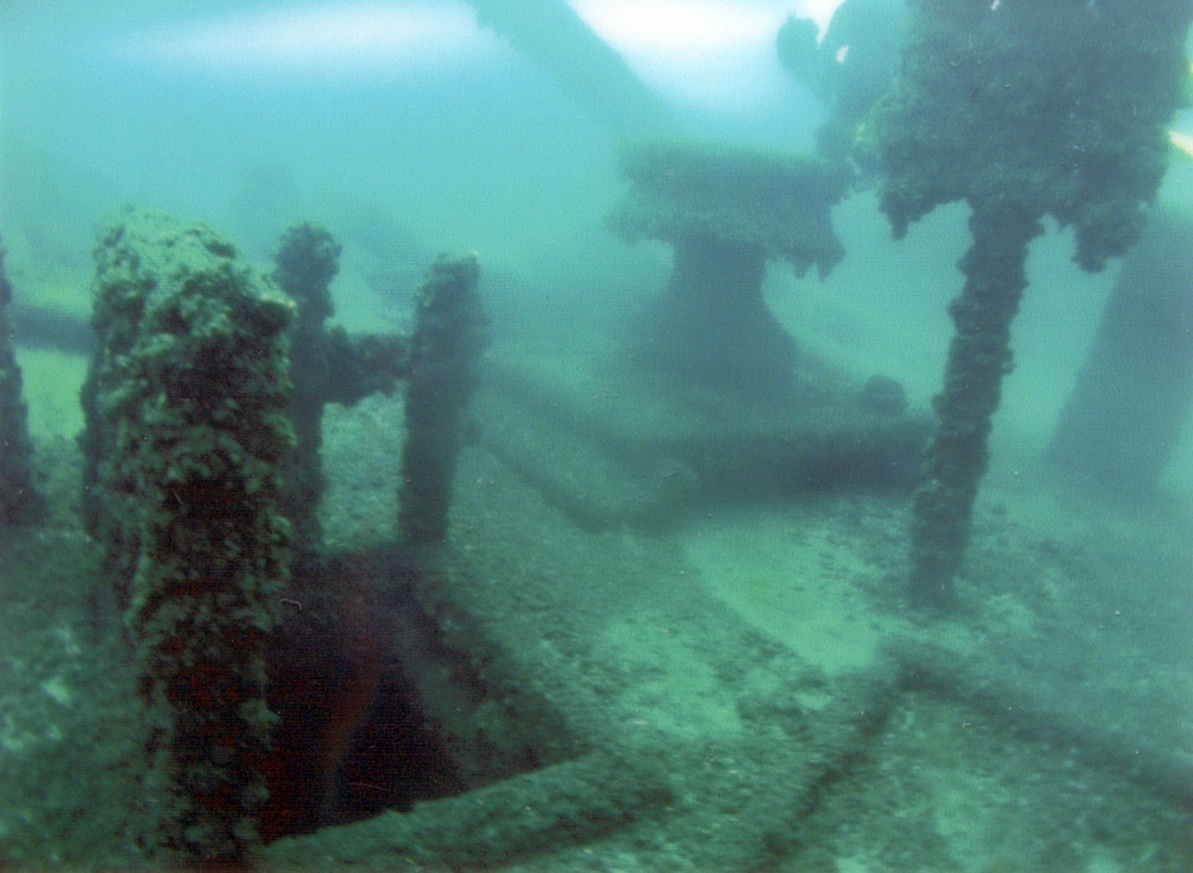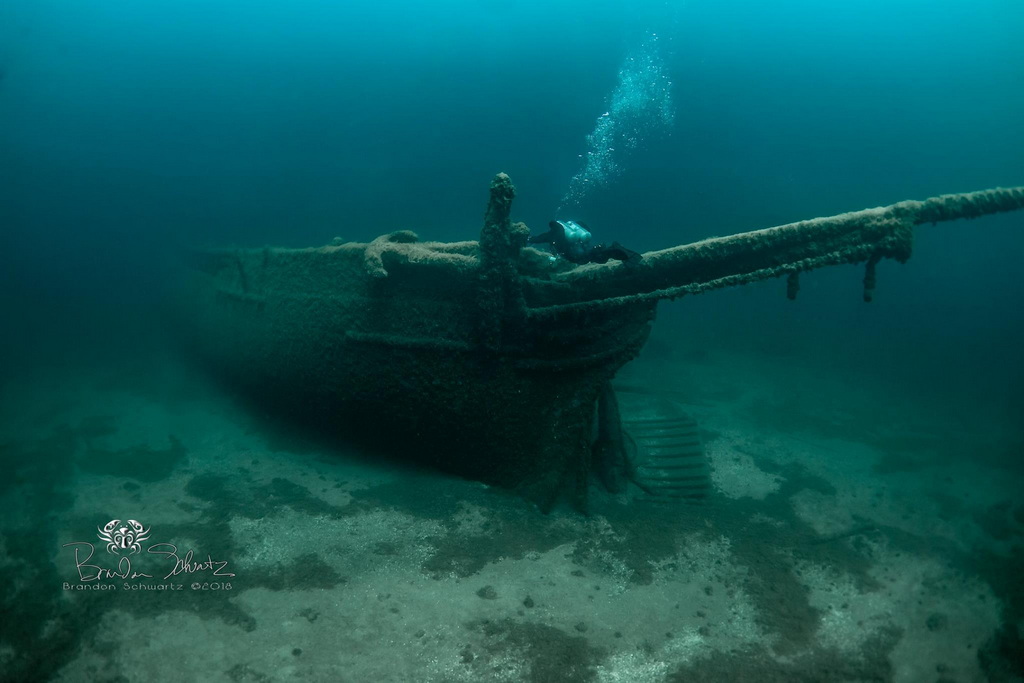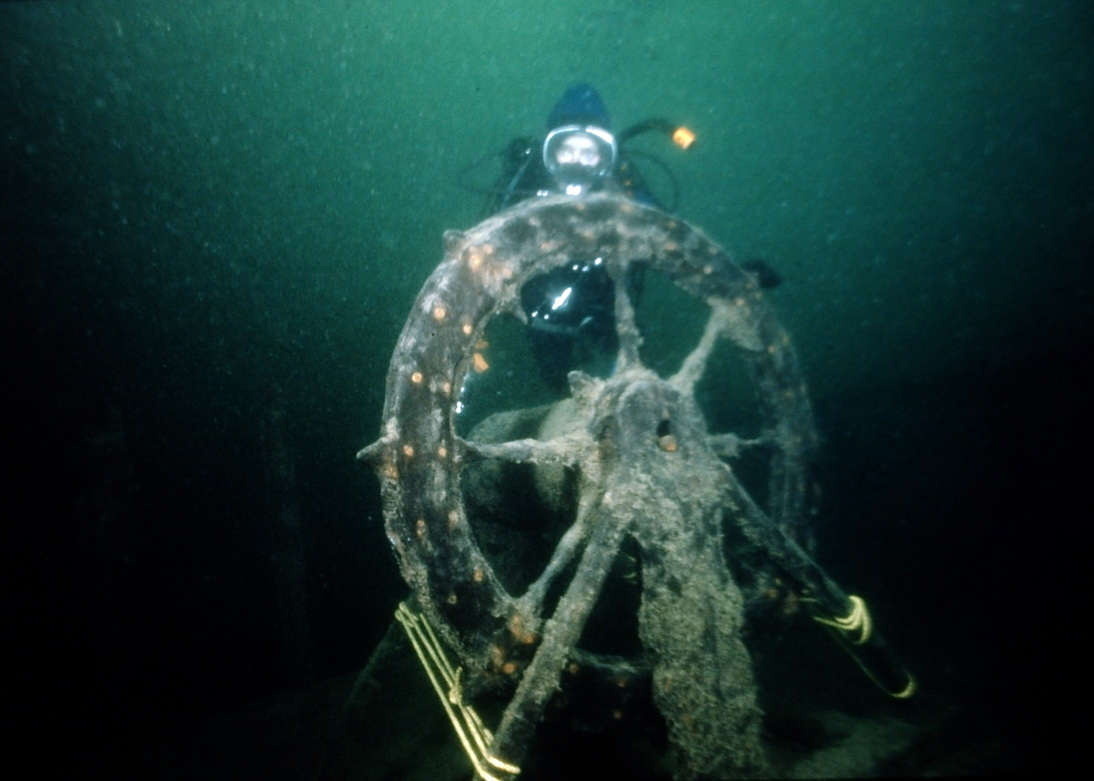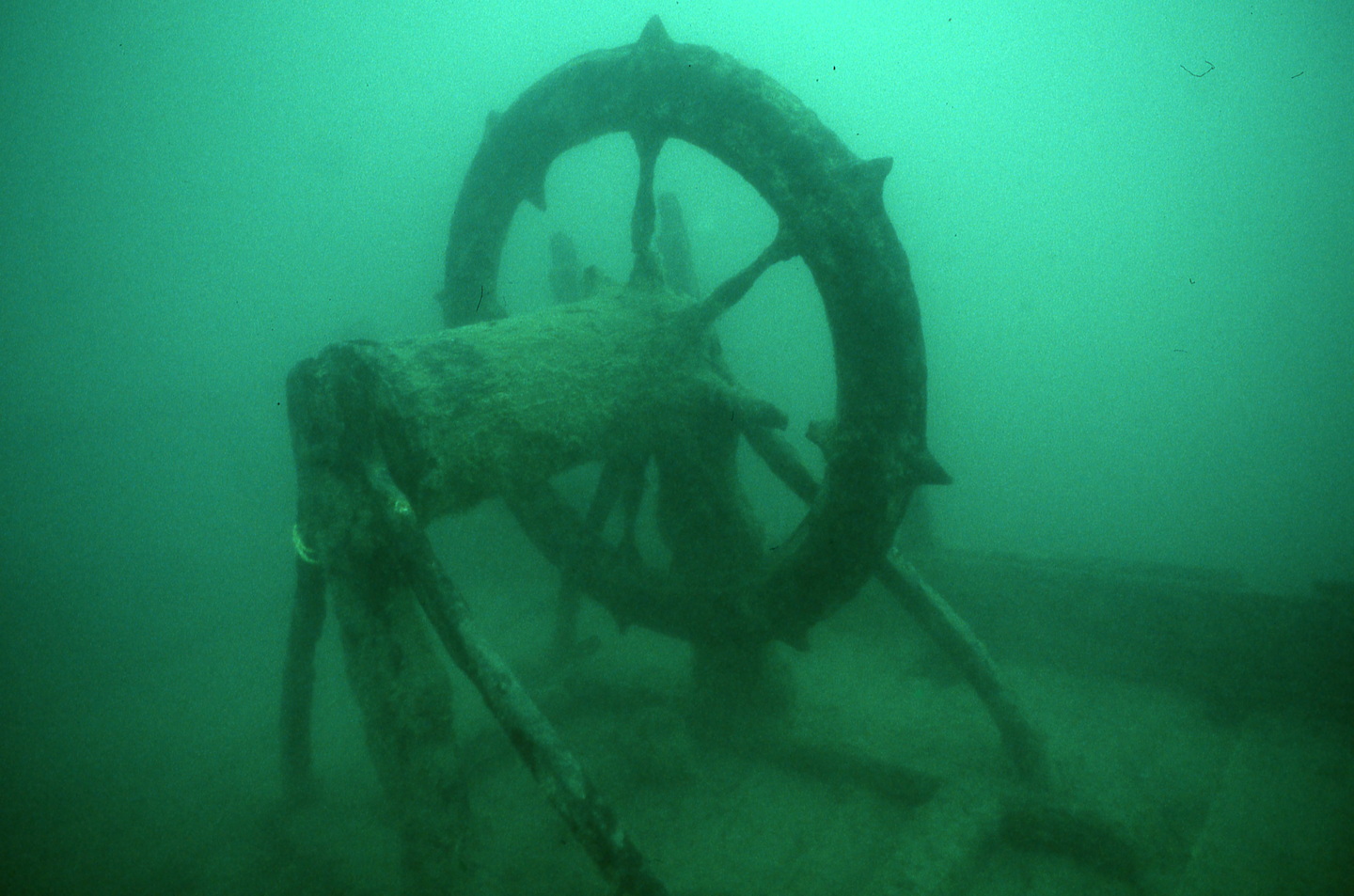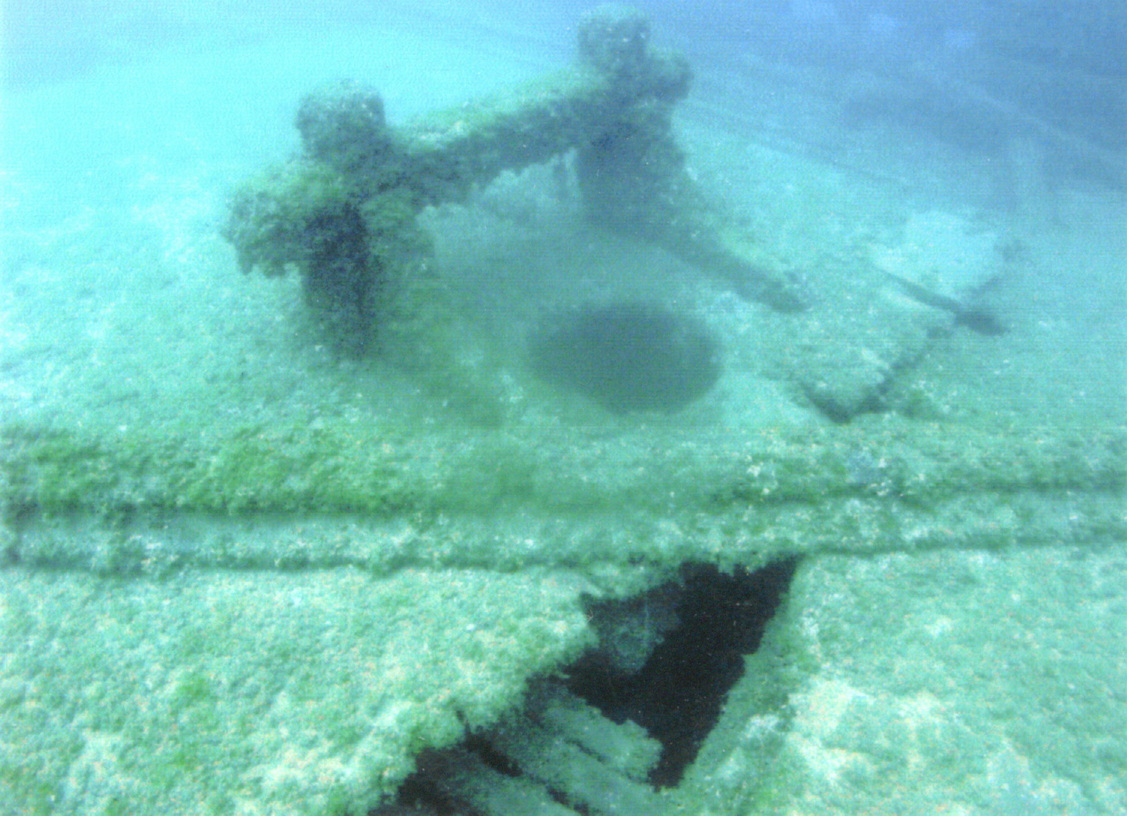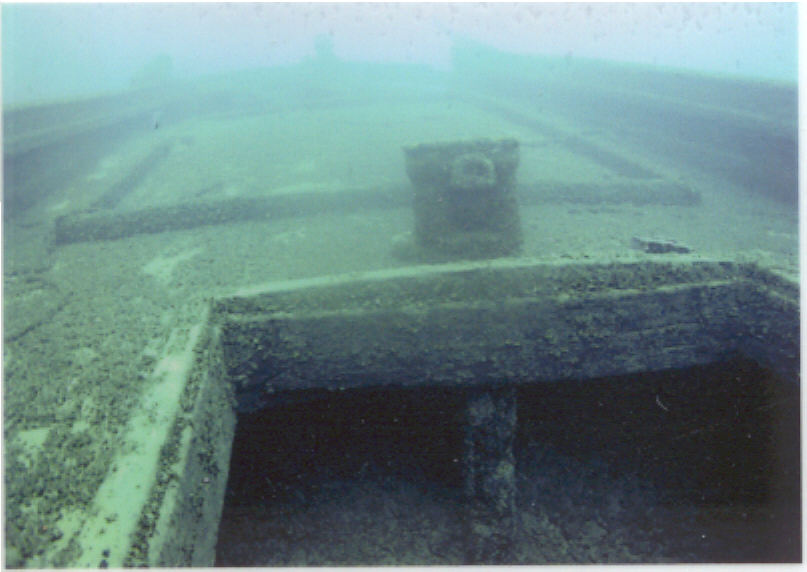Straits of Mackinac Shipwreck Preserve
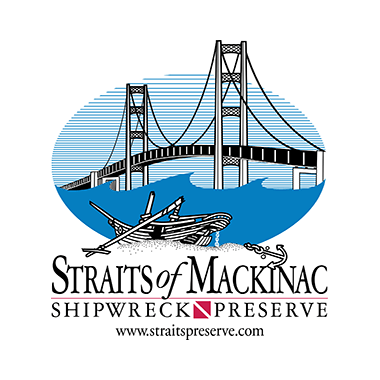
The Straits of Mackinac Underwater Preserve lies at the northern tip of Lakes Michigan and Huron. The five mile long Mackinac Bridge links Michigan’s two peninsulas and marks the dividing point of the two lakes.
The Straits has a well-deserved reputation as a dangerous area to navigate. The region is populated with rocky shoals and shallows that place ships in peril. Perhaps even worse are the storms that can enter the narrow Straits and quickly magnify wind and waves. Over the years large numbers of ships have foundered in the Straits. Many have yet to be discovered.
During the dive season, the Straits of Mackinac Shipwreck Preserve Association places buoys on the major dive sites in the region. More details on the area’s shipwrecks can be found at its website.
In addition to shipwreck diving, divers can also explore shore sites. One of them is located at American Legion Park at the south end of Moran Bay off State Street. It has a dock designed to make it easy for divers to enter and exit the water. This area was used to dock ships for many years and divers will see a variety of relics left behind including pottery, tools, machinery and the like.
Be sure to check out the Straits of Mackinac Shipwreck Museum, on the grounds of Old Mackinaw Point Lighthouse in Mackinaw City. Artifacts can be viewed from local shipwrecks, along with models of several ships showing them as they looked afloat and how they look on the bottom today.
Divers will find the Straits a friendly and active tourist destination. St. Ignace, Mackinaw City and Mackinac Island all host a variety of lodging, restaurants and activities year round to complement your dive trip. For more information on activities and events in the area, consult the websites for the St. Ignace Convention and Visitors Bureau, St. Ignace Chamber of Commerce, Mackinaw City Visitors Bureau, Mackinaw City Chamber of Commerce, and the Mackinac Island Tourism Bureau.
Shipwrecks & Dive Sites
| Wreck Name & Year Lost | Depth | GPS/LAT/LON |
|---|---|---|
| Albemarle (1867) | 12′ | N 45° 42.938 W 084° 33.784 |
| Cayuga (1895) | 100′ | N 45° 43.239 W 085° 11.401 |
| Cedarville bow (1965) | 40′ to 105′ | N 45° 47.235 W 084° 40.248 |
| Cedarville stern (1965) | 70′ to 110′ | N 45° 47.322 W 084° 40.324 |
| Chuck’s Barge | 50′ | N 45° 50.859 W 085° 50.849 |
| Lucy J. Clark (1883) | 50′ | N 45° 39.954 W 085° 01.019 |
| Henry Clay (1850) | 12′ | N 45° 42.842 W 084° 33.897 |
| L.B. Coates (1922) | 8′ | N 45° 39.850 W 084° 29.020 |
| Colonel Ellsworth (1896) | 70′ to 85′ | N 45° 48.743 W 085° 01.056 |
| Dolphin (1869) | 110′ | N 45° 49.132 W 084° 59.748 |
| Eber Ward bow (1909) | 110′ to 145′ | N 45° 48.728 W 084° 49.133 |
| Eber Ward engine (1909) | 110′ to 145′ | N 45° 48.763 W 084° 49.133 |
| Elva (1954) | 120′ | N 45° 52.473 W 084° 35.655 |
| Genesee Chief (1891) | 10′ | N 45° 39.741 W 084° 26.165 |
| C.H. Johnson (1895) | 8′ to 25′ | N 45° 52.526 W 084° 50.144 |
| Leviathan (1891) | 12′ | N 45° 39.650 W 084° 25.950 |
| Fred McBrier (1890) | 100′ | N 45° 48.342 W 084° 55.301 |
| Maitland (1871) | 70′ to 85′ | N 45° 48.250 W 084° 52.547 |
| M. Stalker (1886) | 85′ to 100′ | N 45° 47.629 W 084° 41.045 |
| Minneapolis (1894) | 92′ to 125′ | N 45° 48.502 W 084° 43.898 |
| Northwest (1898) | 52′ to 73′ | N 45° 47.441 W 084 51.516 |
| J.H. Outhwaite (1905) | 15′ to 30′ | N 45° 42.841 W 084 33.502 |
| Perseverance (1864) | 65′ | N 45° 42.080 W 084 26.350 |
| Myrtie M. Ross (1913) | 10′ | N 45° 39.900 W 084 28.980 |
| (former) St. Andrew | 60′ | N 45° 42.050 W 084° 31.811 |
| Sandusky (1856) | 70′ to 80′ | N 45° 47.969 W 084° 50.255 |
| William H. Barnum (1894) | 50′ to 75′ | N 45° 44.708 W 084° 37.866 |
| William Young (1891) | 110′ to 130′ | N 45° 48.777 W 084° 41.923 |
Among the best shipwreck dives in the Straits of Mackinac Underwater Preserve are:
Cedarville
Built in 1927, the Cedarville is the third largest vessel lost on the Great Lakes (after the Edmund Fitzgerald and the Carl D. Bradley). This 604 foot ship sank in a tragic accident on May 7, 1965 in Lake Huron. An ocean-going Norwegian freighter collided midships with the Cedarville in foggy weather. Ten men died when she rolled and sank in 37 degree water. The Cedarville lies on her starboard side broken nearly in two in 105 feet of water. Because she is partly inverted, divers can become disoriented on her. The hull near the bow can be reached at about 40 feet. The bow and stern sections are generally both buoyed, and often there is a mid-ship buoy near the collision site. Divers can visit the pilothouse and large cargo holds. The unloading boom lies along the hull on the bottom. The stern features the galley and crew quarters.
Dolphin
This neat little schooner was located in 2021 by Ken Merryman. She sank after a head-on collision just to port of her stem, and the damage can be seen today. She sits upright on the bottom with her cabin intact and wheel in place, her yawl-boat flattened on the bottom off her stern. Her fore-mast collapsed forward alongside her stem-post, and her main-mast toppled to port. Both masts feature the topmast joints with their semi-circular arches. The now-fragile hatch-covers were in still in place when she was found; please use great care and do not touch or land on them or they will collapse. The cabin can be viewed through the skylight, hatchways, and window openings, and divers are asked to stay outside and not to dig around in the silt. Please do NOT move artifacts around – bottles originally on the bottom have already been moved onto the deck.
Eber Ward
The 213 foot long Eber Ward was built in 1888. She was cut by ice and sank on April 9, 1909 five miles west of the Mackinac Bridge. She is upright, with her hull mostly intact, and is an excellent example of a classic wooden bulk freighter. Her deck can be reached at 110 feet and the bottom near 150 feet. Her engines and boilers provide items of interest for divers. The holds can be fairly easily penetrated by experienced divers. Her port bow has a large and unique “mushroom” anchor. A conventional wood-stock anchor rests on her starboard bow. One of her lifeboats is overturned on the bottom off her starboard stern, and her smokestack lies off the starboard side amidships.
Sandusky
This 110 foot brig, built in 1848, foundered in a Lake Michigan storm with all hands on September 1856. She sits upright with a figurehead still gracing her prow. Over the years, before restrictions were enforced, many of her artifacts were removed by divers. Still, she is an imposing site to visit and is very popular with less experienced divers since she sits in 80 feet of water and her deck can be reached at 70 feet. The figurehead is a replica, the original was illegally removed, and is now on display at the Straits of Mackinac Shipwreck Museum, part of the Old Mackinaw Point Lighthouse in Mackinaw City.
Maitland
The graceful, 141 foot schooner Maitland was built in Canada and launched in 1861. She was converted to American ownership in 1867 and was carrying a load of corn when she collided with two ships on June 11, 1871. She survived a glancing blow by the first but was struck hard on her starboard bow by the second and she sank quickly in Lake Michigan in 85 feet of water. Her masts are gone but her hull is largely intact except for the impact site. Visiting divers can see her windlass and many deck fittings. The remains of her deck cabin top rest inverted on the bottom off her starboard quarter.
Minneapolis
The steamer Minneapolis began life as a passenger and package-freight steamer. First placed in service in 1873, she was converted to a freight only steamer in 1888 by the removal of her upper deck cabins. On April 4, 1894 she was cut by ice and foundered in Lake Michigan. The location is just southwest of the Mackinac Bridge’s south tower in 124 feet of water. Her boiler piping can be reached at about 92 feet. Her bow is broken open and her stern has begun to come apart. Most of her main deck is collapsing downward. Divers can explore her engine and boiler and her deck equipment, including the windlass. The rudder has detached from the hull and rests on the bottom. Game fish frequently inhabit the site. Currents can be very strong near the shipwreck.
William Young
This shipwreck was discovered in 2002 off South Graham Shoal in Lake Huron. She was built in 1863 and had been converted to a schooner-barge when she foundered and was lost on October 5, 1891. Sitting upright in 125 feet of water, the William Young has much of her fittings and gear intact. Her bow has split open, and her chains and anchors are spilled onto the lake floor. Her deck cabin was swept away when she sank. She was carrying a cargo of coal that still fills her holds. Her wheel, dead-yes, pulleys, and other equipment are scattered about the wreck. One mast lies along her starboard side, the other lies in deeper water off her starboard bow. A small amount of wreckage can be found off her stern by following a small line. From there you can view the long slope downwards to much deeper water.
William H. Barnum
The wooden steamer William H. Barnum was built in 1873. She was lost on April 3, 1894 – the day before the Minneapolis. She too was cut by ice and then foundered in about 75 feet of water in Lake Huron close to the Lower Peninsula shoreline. Her stern was dynamited to remove the rudder, which is now on display in St Ignace near the marina. Her hull and engine can be reached at about 50 feet. The bow is more intact and the chain locker area is sufficiently open to permit fairly easy penetration. Except for the stern, the hull itself is intact, though the deck supports were also dynamited by divers for unknown reasons. There are two moorings on this wreck, one at each end of the vessel.

